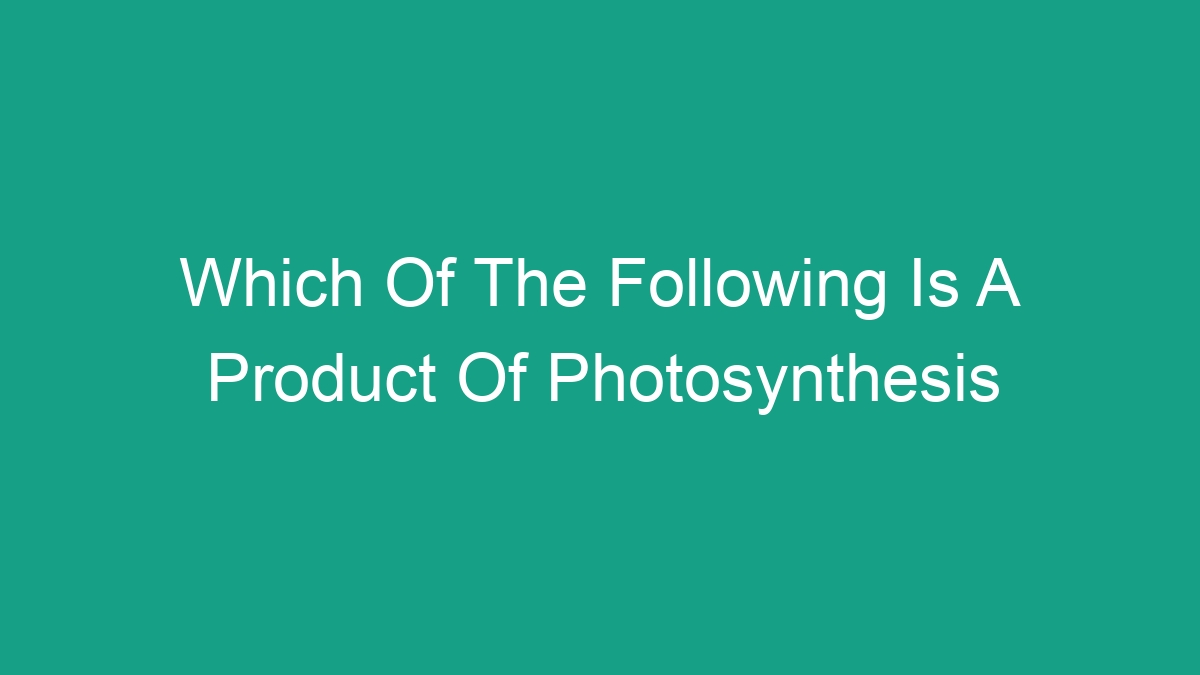
Photosynthesis is a crucial process for all living organisms on Earth, as it is the process by which green plants, algae, and some bacteria convert light energy into chemical energy and produce oxygen as a byproduct. The products of photosynthesis play a critical role in the survival of life on our planet, and understanding them is essential for appreciating the impact of this process on the environment. In this article, we will explore the various products of photosynthesis and their significance.
The Basic Process of Photosynthesis
Before delving into the products of photosynthesis, it’s essential to understand the basic process. Photosynthesis takes place in the chloroplasts of plant cells and involves the following key reactions:
- Light absorption: Chlorophyll and other pigments in the chloroplasts absorb light energy from the sun.
- Water splitting: The absorbed light energy is used to split water molecules into oxygen, protons, and electrons.
- Carbon fixation: Carbon dioxide from the atmosphere is converted into glucose through a series of chemical reactions known as the Calvin cycle.
Now that we have a basic understanding of the process, let’s explore the different products of photosynthesis in more detail.
Primary Products of Photosynthesis
The primary products of photosynthesis are the molecules that are directly produced during the process. These include:
| Product | Formula | Description |
|---|---|---|
| Glucose | C6H12O6 | The primary product of photosynthesis, glucose is a simple sugar that serves as a crucial source of energy for plants and other organisms that consume plant matter. |
| Oxygen | O2 | Oxygen is released as a byproduct of water splitting during photosynthesis and is essential for the respiration of organisms, including plants themselves. |
These primary products are the immediate outputs of the photosynthetic process and have far-reaching implications for the environment and global ecosystems.
Secondary Products of Photosynthesis
In addition to glucose and oxygen, photosynthesis also leads to the production of secondary products that are essential for plant growth and development. These include:
- Starch: Glucose molecules produced during photosynthesis are often linked together to form starch, which serves as a long-term energy storage molecule for plants.
- Cellulose: Another essential product of photosynthesis, glucose molecules are also used to form cellulose, a key component of plant cell walls.
- Chlorophyll: While not a direct product of photosynthesis, chlorophyll is synthesized using the energy and raw materials generated through the process, enabling plants to continue photosynthesizing.
These secondary products of photosynthesis play critical roles in the structure and function of plant cells and have implications for various industries, including agriculture, biofuels, and materials science.
Environmental Impact of Photosynthesis Products
The products of photosynthesis have a profound impact on the environment, influencing the levels of atmospheric oxygen, carbon dioxide, and other greenhouse gases. Understanding this impact is crucial for addressing climate change and sustainable resource management.
- Oxygen Production: The release of oxygen during photosynthesis is vital for maintaining the atmospheric oxygen levels necessary for aerobic respiration in all living organisms.
- Carbon Sequestration: The conversion of carbon dioxide into glucose and other organic compounds helps mitigate the levels of this greenhouse gas in the atmosphere, playing a significant role in regulating global climate patterns.
- Food and Energy Supply: The production of glucose and other sugars through photosynthesis forms the basis of the food chain, providing energy for plants and serving as a source of nutrition for herbivores and omnivores.
These environmental impacts highlight the critical role of photosynthesis in shaping Earth’s ecosystems and the need for sustainable practices to protect and enhance this process.
Applications of Photosynthesis Products
Beyond their environmental significance, the products of photosynthesis have diverse applications in various fields, driving innovation and economic development. Several key applications include:
- Agriculture: The production of glucose and other sugars through photosynthesis is essential for crop growth and yield, influencing agricultural practices and food security globally.
- Renewable Energy: The potential for biofuels derived from plant biomass, including products of photosynthesis, offers sustainable alternatives to fossil fuels for meeting energy demands.
- Biotechnology: The synthesis of valuable compounds such as pharmaceuticals, bioplastics, and biochemicals can be achieved using plant-derived materials, rooted in the products of photosynthesis.
These applications highlight the versatility and value of photosynthesis products in addressing contemporary challenges and driving progress in various sectors.
Conclusion
Photosynthesis is a fundamental process that sustains life on Earth, producing essential products such as glucose, oxygen, and various organic compounds. These products have profound environmental impacts, supporting ecosystems and influencing global climate patterns. Furthermore, they offer diverse applications in agriculture, renewable energy, and biotechnology, driving innovation and economic development. Understanding the products of photosynthesis is critical for appreciating the significance of this process and harnessing its potential for a sustainable future.


